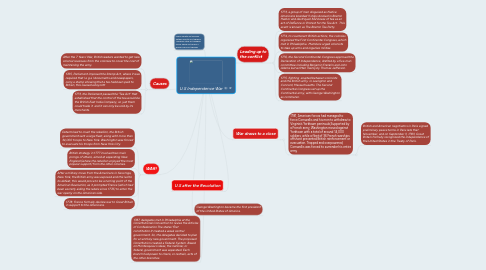U.S Independence War
da Mario Gárate


1. George Washington became the first president of the United States of America.
2. 1787, delegates met in Philadelphia at the Constitutional Convention to revise the Articles of Confederation.The states' first constitution.It created a weak central government. So, the delegates decided to plan for an entirely new government. The proposed Constitution created a Federal System. Based on Montesquieu's ideas, the national, or federal, government was separated. Each branch had power to check, or restrain, acts of the other branches.
3. Causes
3.1. After the 7 Years' War, British leaders wanted to get new colonial revenues from the colonies to cover the cost of maintaining the army.
3.2. 1765, Parliament imposed the Stamp Act, where it was required that l e g a l documents and newspapers, carry a stamp showing that a tax had been paid to Britain, this caused a boycott
3.3. 1773, the Parliament passed the “Tea Act” that established that the control of the tea would be the British East India Company, so just them could trade it and it can only be sold by its merchants.
4. WAR!
4.1. Determined to crush the rebellion, the British government sent a large fleet, along with more than 34,000 troops to New York. Washington was forced to evacuate his troops from New York City.
4.2. British strategy in 1777 involved two main prongs of attack, aimed at separating New England (where the rebellion enjoyed the most popular support) from the other colonies.
4.3. After a military move from the Americans in Sara toga, New York, the British army was exposed and this led to its defeat, this would prove to be a turning point of the American Revolution, as it prompted France (which had been secretly aiding the rebels since 1776) to enter the war openly on the American side.
4.4. 1778, France formally declare war to Great Britain in support to the Americans.
5. U.S after the Revolution
6. Mario Gárate A01283765 Sathya Treviño A01283807 Gerardo Steel A01283896 César Serna A01283744 David Floyd A01283892
7. Leading up to the conflict
7.1. 1773, a group of men disguised as Native Americans boarded 3 ships docked in Boston Harbor and destroyed 342 boxes of tea as an act of Defiance or Protest for the Tea Act. This event is known as The Boston Tea Party.
7.2. 1774, to counteract British actions, the colonies organized the First Continental Congress, which met in Philadelphia. Members urged colonists to take up arms and organize militias.
7.3. 1776, the Second Continental Congress approved the Declaration of Independence, drafted by a five-man committee including Benjamin Franklin and John Adams but written mainly by Thomas Jefferson.
7.4. 1775, fighting erupted between colonists and the British army in Lexington and Concord, Massachusetts. The Second Continental Congress set up the Continental army, with George Washington as commaner.
8. War draws to a close
8.1. 1781, American forces had managed to force Cornwallis and his men to withdraw to Virginia’s Yorktown peninsula,Supported by a French army, Washington moved against Yorktown with a total of around 14,000 soldiers, while a fleet of 36 French warships offshore prevented British reinforcement or evacuation. Trapped and overpowered, Cornwallis was forced to surrender his entire army
8.1.1. British and American negotiators in Paris signed preliminary peace terms in Paris late that November, and on September 3, 1783, Great Britain formally recognized the independence of the United States in the Treaty of Paris.
